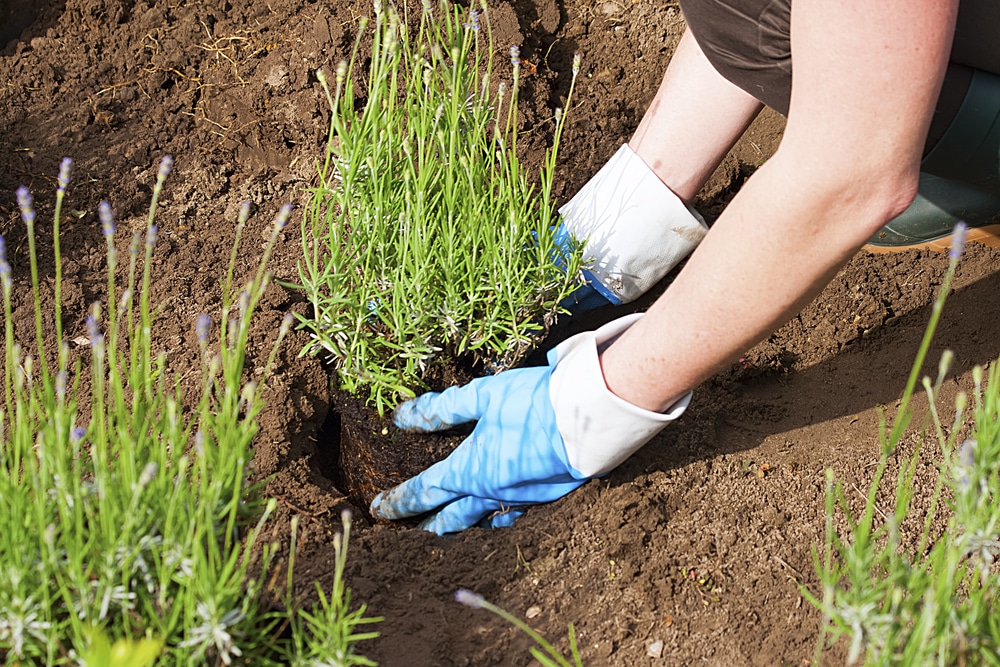Last Updated on
If you’re looking for a beautiful, fragrant plant to add to your garden, look no further than lavender! Lavender is a flexible plant that works well in both herb and floral gardens. It’s also easy to care for, making it the perfect plant for beginner gardeners.
But when is the best time to plant them? Keep reading to find out when to plant lavender for the best results.
The Benefits of Growing Lavender in Your Garden
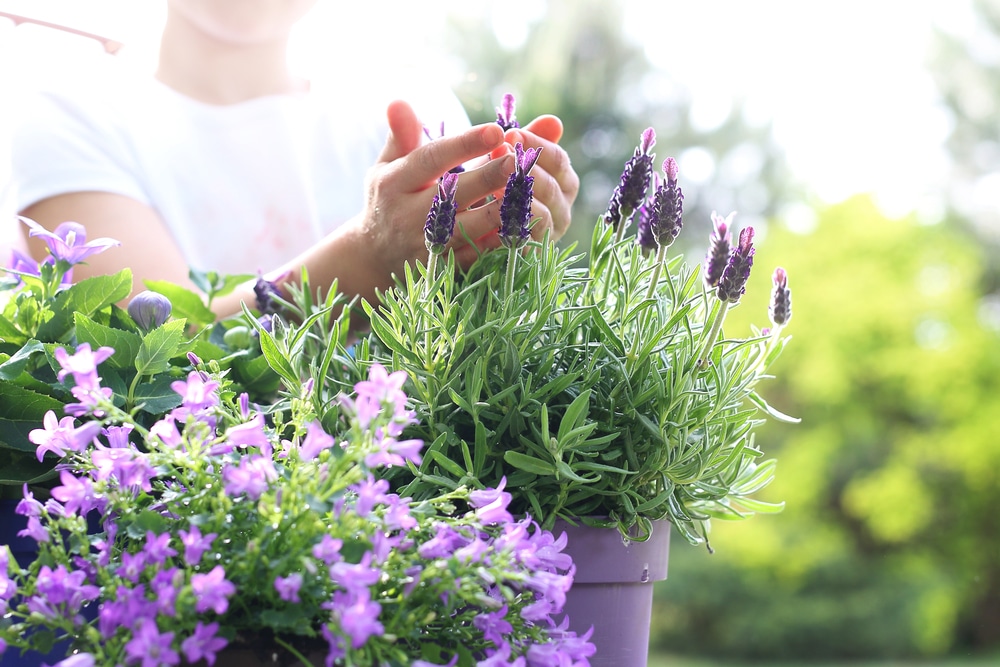
Lavender, with its delicate purple flowers, is a favourite of gardeners and non-gardeners alike. Not only does it add beauty to your landscape, but lavender also has many practical uses. It can be used as a natural insect repellent and a culinary herb.
Lavender is the ideal plant to add to your garden if you want to create a tranquil haven because it is also used in aromatherapy for its relaxing effects.
Additionally, the plants attract pollinating insects to gardens, such as bees and butterflies. So not only will you enjoy the beauty of lavender in your garden, but you’ll also get to enjoy the benefits of having these pollinators around.
Lavender also makes excellent cut flowers. So if you’re looking to add some lovely, fragrant flowers to your home, lavender is a great option.
Finally, the plants typically live for about five years. However, they can sometimes last for up to ten years with proper care. After that time, they will start to decline, but you can always replant new lavender plants to keep your garden looking beautiful.
Common Lavender Varieties in the UK
There are many lavender varieties, but the most common ones grown in the UK are the following:
English Lavender (Lavandula angustifolia) is the most popular type of lavender. It grows best in warm climates and has a sweet, floral aroma.
French Lavender (Lavandula stoechas) is a heat-tolerant variety often used in cooking. It has a strong, pungent aroma.
Spanish Lavender (Lavandula latifolia) is the largest type of lavender. This variety grows best in hot, dry climates and has a woodsy, minty aroma.
Lavandin (Lavandula x intermedia) is a hybrid of English and French lavender. It’s the most popular type grown on commercial lavender farms.
Portuguese lavender (Lavandula lusitanica) is a hybrid of English and Spanish lavender. It has a sweet, floral aroma and grows well in cold and warm climates.
When to Plant Lavender
In general, lavender should be planted in the spring or fall. If you live in an area with mild winters, you can plant lavender as early as February. If you reside in an area with harsh winters, wait to plant until the weather has warmed up in April or May.
Timing is essential when planting English lavender and other varieties. If you plant them too early, they may not bloom. If you plant them too late, they may not have enough time to establish a robust root system before the cold weather arrives.
How to Plant Lavender in Your Garden
Lavender can be planted in either a pot or in the ground.
If you’re planting in the ground, choose a location that gets full sun. Dig a planting hole large enough to accommodate the plant’s roots, and be sure to loosen the soil before placing the plant in the spot. If you’re planting more than one lavender plant, make sure they are spaced at least 18 inches apart.
Water your lavender plants well after planting, and then water them regularly (about once a week) during the first growing season. After that, they will only need to be watered during periods of extended drought.
Now that you know everything there is to know about planting lavender, it’s time to get out there and add this beautiful plant to your garden!
How to Grow Lavender in Pots or Containers
Lavender can also be grown in pots or containers. If you’re growing lavender in a pot, choose one at least 18 inches wide and has drainage holes. Use a well-draining potting mix. In addition, water your lavender plant regularly (about once a week).
When planting lavender in a container, you can start with a young plant or grow lavender from seed. If you’re starting with a young plant, be sure to transplant it into a larger pot as it grows.
If you’re growing lavender from seed, sow the seeds in early spring (about six weeks before the last frost date). Place the seeds on the soil’s surface and lightly press them down. Water the seeds well, and then place the pot in a sunny location. Keep the soil moist, and thin out the seedlings once they have sprouted. Transplant the seedlings into individual pots when they are large enough to handle.
No matter how you choose to grow lavender, be sure to give it plenty of sunlight and well-drained soil. With a bit of love and care, your lavender plant will thrive!
How to Take Lavender Cuttings in 6 Easy Steps
Lavender (Lavandula) is a fragrant, drought-tolerant herb that’s easy to grow in containers or the ground. It’s also one of the easiest garden plants to propagate from cuttings! Here’s a step-by-step guide on how to take lavender cuttings:
Step 1: Prepare Your Tools and Materials
To take lavender cuttings, you will need
- A healthy lavender plant
- Pruning shears
- Rooting hormone powder (optional)
- Potting mix
- Containers or pots
Step 2: Choose Healthy Stems
Select healthy, non-flowering lavender stems that are about six inches long. Using sharp pruning shears, cut the stem just below a node (the point where a leaf meets the stem). Strip off any leaves from the lower two-thirds of the cutting.
Step 3: Dip the Cutting in Rooting Hormone
Dip the cut end of the lavender cutting into rooting hormone powder.
Step 4: Place Your Cutting in a Pot or Container
Fill your container or pot with a moist potting mix. Please make a small hole in the potting mix and insert the lavender cutting, making sure to bury it up to the node.
Step 5: Cover the Pot
Cover the entire pot or container with a plastic bag and secure it with a rubber band. Then, place it in a warm location (about 70 degrees Fahrenheit) and wait for new growth to emerge.
Step 6: Remove the Plastic Bag
Once new growth appears, remove the plastic bag and water regularly. When the lavender plants are big enough, transplant them into individual pots or the ground.
That’s it! You’ve successfully propagated lavender from cuttings. Enjoy your new plants, and be sure to share some with friends!
How to Harvest English, French, and Spanish Lavenders
There are many different types of lavender, but the most common are English, French, and Spanish lavender. Each type has its unique aroma.
When harvesting lavender, leaving some stem attached to the flower head is essential so that oil production is not inhibited.
The best time to harvest lavender is just before the flowers open. Harvesting later in the day will yield more essential oil, but you’ll also risk damaging the plant. To harvest lavender, cut the stems about an inch above the flower head using sharp scissors or pruning shears.
It’s best to harvest lavender on a dry day when the dew has dried. Harvesting wet lavender will cause it to spoil quickly.
After harvesting, hang the stems upside down in a cool, dark place until they are completely dry. The drying time depends on the humidity and temperature of your climate but typically takes about two weeks.
Once the lavender is dry, strip the flowers from the stems and store them in an airtight container. The flowers can be kept for up to six months.
Essential Lavender Planting Tips
Lavender is an incredibly versatile and fragrant herb with a wide range of uses, from culinary to decorative. While the plant is easy to grow, you should know a few things before you get started. Here are some essential tips for growing lavender plants.
- An ideal time to plant lavender is in the early spring, before the last frost. However, you can also plant it after the first frost in the fall.
- Lavender plants prefer well-drained soil that is rich in organic matter. Improve the drainage of your soil by adding sand or gravel.
- Place your plants in a sunny spot. They need six or more hours of direct sunlight per day.
- It is vital to water lavender plants regularly, especially during summer. However, be sure not to overwater them, leading to root rot.
- Lavender plants do not need a lot of fertiliser, but you can give them a light application of organic fertilisers once or twice a year.
- Lavender is relatively pest and disease-free, but aphids, mites, or whiteflies can occasionally attack it. If this happens, treat the plants with a pesticide or insecticidal soap.
- Inspect your plants regularly for any pests or diseases. The most common pests that affect lavender plants are aphids, mites, and scale insects. The most common diseases are powdery mildew and root rot.
- Pruning lavender plants is essential for keeping them healthy and producing many flowers. Prune the plants in late winter or early spring before new growth appears.
- Lavender can be harvested at any time during the growing season, but it is best to harvest the flowers just before they open. To harvest the lavender, cut the stems about an inch above the flower buds.
Challenges Faced by Gardeners When Growing Lavender
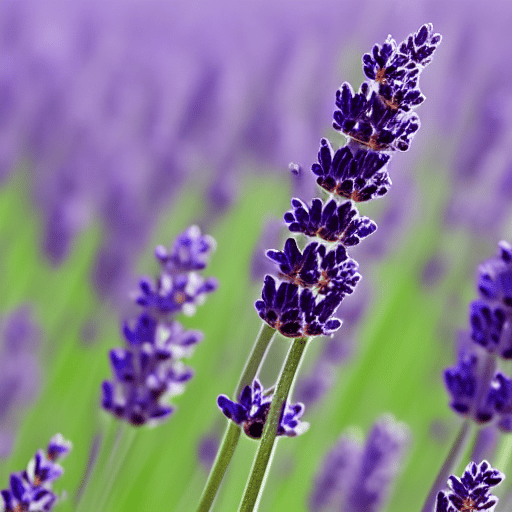
Lavender plants are popular for their fragrant pale purple blooms, but they can be challenging to grow. Below are some of the challenges often faced by gardeners when growing lavender:
- Temperature: Lavender plants need warm temperatures to thrive. The plants will not do well in cold weather and may die if exposed to frost.
- Soil: Lavender plants need well-drained soil that is pH balanced. A too acidic or alkaline soil, the lavender plant may not grow properly.
- Sunlight: Lavender plants need at least six hours of sunlight per day in order to bloom properly. Without enough sunlight, the plant may not produce flowers.
Despite these challenges, lavender plants are worth the effort because they are beautiful and fragrant additions to any garden. With proper care and attention, you’ll soon enjoy the beauty of lavender flowers in your backyard.
Practical Uses of Lavender
Lavender is a versatile herb that has many practical uses. Here are just a few of them:
Natural Insect Repellent
Lavender oil can be used as a natural insecticide or repellent. It can also be used to soothe insect bites and stings.
Aromatherapy
The fragrance of lavender boosts mood improves cognitive function and promotes relaxation. It is used in aromatherapy to help ease feelings of anxiety, depression, stress, and headaches.
To enjoy the benefits of lavender, add a few drops of essential oil to a diffuser or burner.
You can also use lavender oil in your bathwater. Add a few drops of lavender oil to your bath salts for a relaxing and therapeutic soak.
Soap
Make your soap with fresh lavender flowers. Combine one cup of melted coconut oil, one cup of lye, and two cups of water. Stir in the flowers and let them steep for about an hour. Pour the mixture into moulds and let it cool overnight.
Closet Freshener
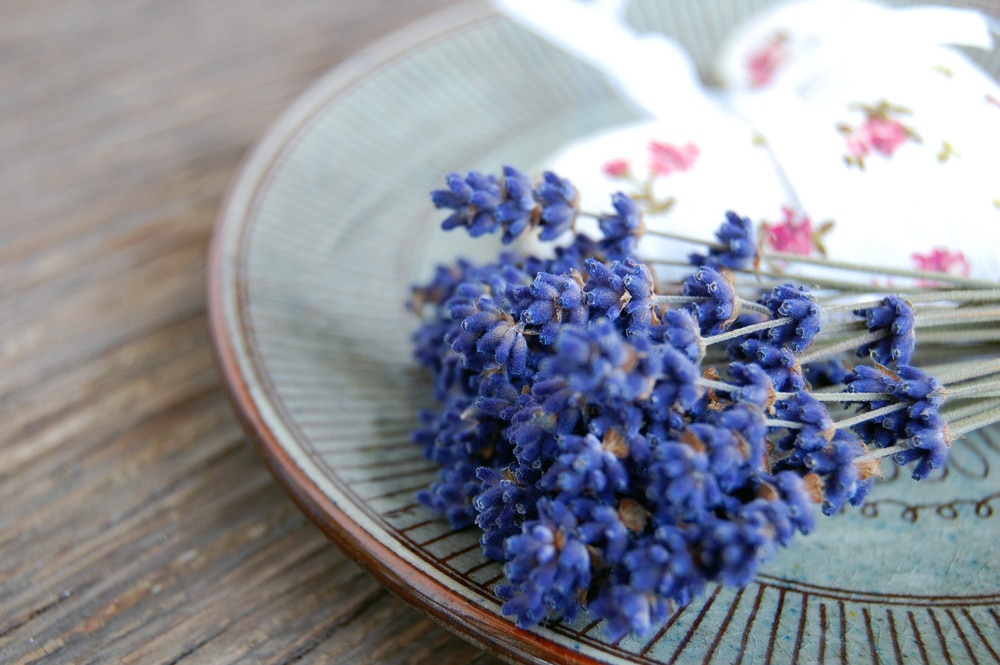
Lavender sachets can be placed in closets, drawers, and suitcases to keep them smelling fresh.
Place a few tablespoons of dried lavender flowers in a small muslin bag or fabric square to make a lavender sachet. Tie the bag with a piece of twine or ribbon.
Sachets can also be made from fresh lavender blooms, but they will only last for about two weeks.
Baking
Lavender can also be used in baking. Add a teaspoon of dried lavender flowers to your favourite cookie or scone recipe.
Lavender Tea and Lemonade
Lavender can be used to make tea, which is beneficial for relaxation and alleviating insomnia. To prepare lavender tea, add one teaspoon of dried lavender flowers to a cup of boiling water. Steep for five minutes and then strain.
The flowers can also be made into a refreshing drink. To make lavender lemonade, heat 1/2 cup honey and 1/2 cup fresh lavender flowers over low heat in a saucepan until just warm. Remove from heat and let steep for 15 minutes.
In a large pitcher, combine lemon juice, water, and lavender honey mixture. Add ice cubes and stir well. Serve immediately.
All in all, lavender is an easy-to-grow herb that has many practical uses. It is a great choice for gardeners of all experience levels.
FAQ About Growing Lavender
What Is the Best Time of Year to Plant Lavender?
The best time to plant lavender is in the early spring, before the last frost. However, you can also plant it in the fall, after the first frost.
What Month Should I Plant Lavender?
March is the best month to plant lavender.
Can You Plant Lavender Any Time of Year?
Yes, you can plant lavender any time of year. However, the best time to plant it is in the early spring or fall.
How Deep Do I Need to Plant Lavender?
It would be best if you planted lavender about two inches below the surface of the soil. They should also be spaced about 18 to 24 inches apart.
Does Lavender Come Back Every Year?
Yes, lavender is a perennial plant, which means it will come back every year.
When Does Lavender Bloom?
Lavender typically blooms in the summertime. However, the exact time it takes to bloom depends on the variety of lavender you grow.
How Do You Water Lavender?
The best way to water lavender is to water it at the base of the plant, using a soaker hose or drip irrigation. Be sure not to wet the plant’s leaves, as this can cause them to rot.
When Should I Fertilise My Lavender Plants?
It would be best to fertilise your plants in early spring and again in mid-sum. Use a fertiliser that is high in phosphorus.
What Should I Do if My Lavender Plants Get Too Big?
If your lavender plants get too big, you can prune them back to about 12 inches tall. You can also divide the plants into several new clumps.
What Is the Difference Between English and French Lavender?
The main difference between English and French lavender is the size of the plant. English lavender plants are smaller, while French lavender plants are larger.
Where Should I Plant Lavender?
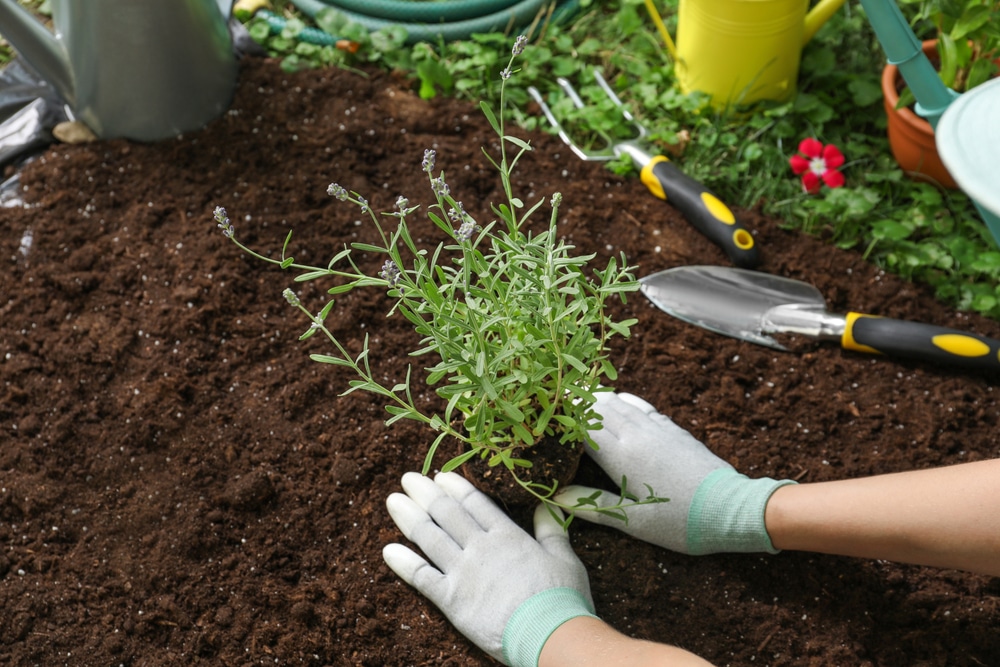
Lavender plants prefer well-drained soil that is rich in organic matter. It is possible to improve the drainage of your soil by adding sand or gravel. Place your plants in a sunny spot. The plants need at least six hours of direct sunlight each day.
How Much Water Does Lavender Need?
Lavender needs only moderate amounts of water. Water deeply, but do not wet the leaves. Wet leaves can lead to fungal diseases.
What if I Live In a Cold Climate?
You should plant your lavender plants in pots and bring them indoors during the winter months.
How Long Does Lavender Take to Grow?
Lavender takes about two to three years to reach its full size.
How Often Should I Prune My Lavender Plants?
Lavender doesn’t need a lot of pruning. You can shear off the flowering tips after the blooms have faded to encourage new growth. Prune lightly, and avoid removing more than one-third of the plant at a time.
Can Lavender Plants Cause Skin Irritation?
Unknown to many, lavender oil may cause skin irritation in some people. If you are concerned about this, you can wear gloves when handling the plants.
How Do I Get Rid of Pests From My Lavender Plants?
If you have pests on your lavender plants, you can remove them by hand. You can also use a garden hose to blast them off. If the infestation is severe, you can treat the plants with insecticidal soap or neem oil.
Do Lavender Plants Attract Bees?
Lavender plants do attract bees. This is because they produce nectar, which is a food source for bees.
What Should I Do With My Lavender Plants in the Winter?
You should consider growing your lavender plants in pots and bringing them indoors during the winter months. You can also mulch your plants with straw or leaves to protect them from the cold.
Can I Use Lavender in Cooking?
Yes, you can use lavender in cooking. It has a floral flavour that is used in many Mediterranean dishes. Lavender can also be used to make tea.
Surround Yourself With Fragrant Blooms
Lavender produces fragrant flowers that can be enjoyed all year long. It’s important to know when to plant lavender so that you can enjoy its blooms at their peak!
Do you have more questions about how to plant lavender or the best lavender growing conditions? Let us know in the comments below! And be sure to check out our other gardening articles for more helpful tips and advice.
Paul is the type of person who never met a problem he couldn’t fix. He can always be found tinkering with something in his house, even if it isn’t broken! His tips and tricks are often shared on our site. He’s the one you call when something breaks because he has been known to improvise fixes for everything from leaky faucets to malfunctioning dryers.

